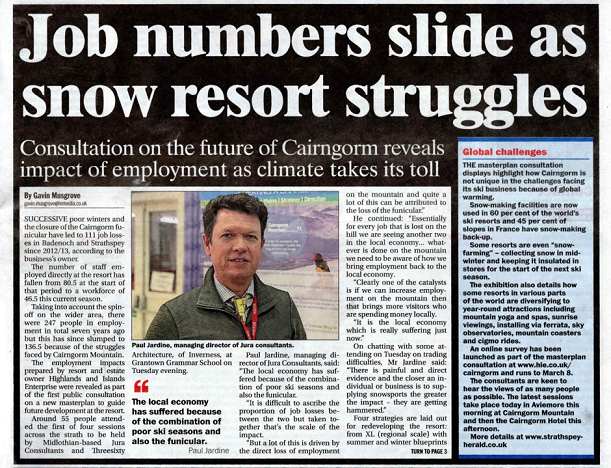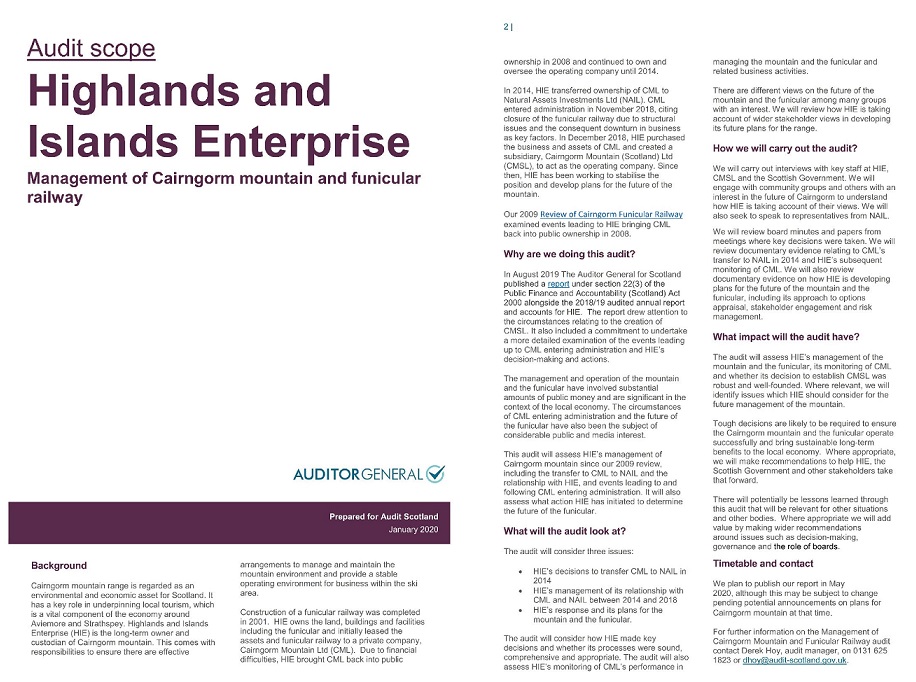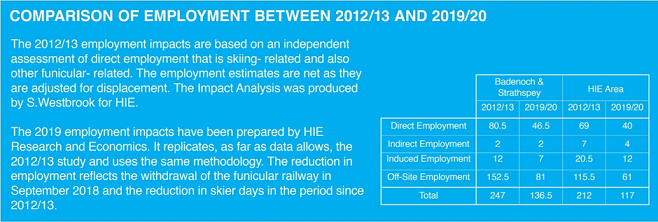It’s now 16 months since the Cairngorm funicular closed and almost 15 months since the operator (Cairngorm Mountain Ltd) went into liquidation, but of course as any regular reader of this website will know, the problems on Cairn Gorm go back much further. At last, after all of HIE’s dithering and delay (see here) the public consultation phase of the masterplan process to set out a plan for the future of Cairn Gorm is now underway.
For anyone who is not aware, the masterplan consultants have launched an online survey which is open to anyone interested in the future of Cairn Gorm (winter and summer). I would encourage anyone reading this article interested in the future of Cairn Gorm to complete the survey (links at bottom of post) and pass on the details to any friends and family who you think might be interested. The survey closes on 8 March 2020.
Like most surveys, the questions can lead the person being surveyed. I recommend that anyone completing it makes sure that they get into their response the opinions and recommendations they want to communicate to the masterplan consultants.
The Flaws in the masterplan process
Having met and spoken with the masterplan consultants from Jura Consultants and Threesixty Architecture, I believe that they are all well-intentioned, well aware of the problems besetting Cairngorm Mountain and are intent on producing and objective and professional masterplan. The problems lie with the constraints placed on the masterplan consultants by HIE and the ‘fake news’ being put out by HIE around this consultation process.

Flaw 1 – Assumption on the funicular
Appallingly, HIE has instructed the consultants to prepare their masterplan on the assumption that the funicular will be repaired. More efficient and less costly uplift solutions are available which could be installed within the timescale to repair the funicular (see here) and would have a much reduced environmental impact. The consequence of HIE’s restriction on the masterplan is that the public has no real say on whether in excess of £10m should be spent repairing the funicular! This is a good example of HIE’s callous and dismissive attitude to public consultation on Cairn Gorm. It would appear that HIE thinks it knows best. Those of us who think differently need to continue to make our views known.
HIE has been leaking to the press since November that a ‘so-called’ business plan is being prepared that will go to the Scottish Government requesting funding for repairing the funicular. Originally the case was to be submitted in December, then January, and now we find that it is still to be submitted.
HIE is also under investigation by Audit Scotland over its management (or mis-management) of the award of the operating contract to Natural Retreats, its lack of management and audit of Natural Retreats’ performance and the way HIE has managed Cairngorm Mountain since Natural Retreats’ subsidiary went into liquidation.

If Audit Scotland’s report is highly critical of HIE, resulting in the business case for repair of the funicular not being approved by the Scottish Government, then a considerable amount of the masterplan work will have to be re-done at considerable public expense and delay.
Flaw 2 – The lack of a focussed survey of the market
In building any business proposal a key feature that is integral to any business plan is to know and understand your market. Do the current operators of Cairn Gorm understand (or want to understand) the visitor market?
Winter market: The snowsports business on Cairn Gorm (currently operated by CMSL) has been losing market share for many years – and long before the closure of the funicular.

The average number of skier days in Scotland between 2003 and 2013 was 195,730 (and that was skewed upwards by the outlier figures in 2010). Interestingly, the average number from 2014-18 was very similar – 195,374 – and yet the CairnGorm Mountain share of the market has fallen dramatically. Please note that this market share collapse came about before the Funicular failed. Between 2014-2018, with the exception of 2017, it is also clear that snow conditions were fairly good, so poor snow was not the reason for the market share collapse.
The Masterplan consultants need to understand why that happened, otherwise, simply repairing the funicular will at best only get back to this lower market share which was one of the main causes of failure. The Masterplan market research makes no targeted effort to find out the opinions of a much wider market than those who live locally (i.e. the snowsports visitors from elsewhere in Scotland and the UK, and many of whom are no longer coming to Cairn Gorm).
Summer Market: Visitor numbers using the funicular have never made the projected numbers, and like the winter visitor numbers have been falling over the last 5 years.
“Non skiing passenger numbers were predicted to be 160,000 per annum and this number was surpassed in the early years of service. The average was 174,935pa in the first 5 years of service [180,000: 182,000: 177,000: 164,046 and 171,406]. However in the last 5 years, prior to the failure of the funicular, the average number was just 130,990 [119,585: 127,092: 137,776: 138,712: and 131,788]. It’s clear that non skiing passenger numbers have fallen significantly and are well below predictions. It should also be kept in mind that many of these passengers were not paying the full fare. Coach parties receive large discounts and 2 for 1 offers on Ipson and Groupon bolster the number but are also uneconomic.
In the time period since the Funicular was brought into service the summer tourism business in Strathspey has increased considerably with many adventure tourism businesses having been set up. During the time when numbers in Strathspey have been increasing, the numbers using the Funicular have been decreasing”
(Excerpt from Alan Brattey’s Parkswatch post “The Cairn Gorm Funicular: Repair or Remove?” (see here)).
Working in the tourism sector in Strathspey, I am well aware of the wealth of attractions that summer visitors have within the Cairngorms National Park. In Strathspey, visitors are also well placed to explore the wider Speyside area and the many attractions of Moray, Nairn and the Moray Firth coast. Within that competitive context of plenty of attractions for summer visitors, it is important for the Cairn Gorm business to understand the summer market before it can develop any new or modified offerings to visitors. Will the masterplan consultants properly research this during their work, and if they do, will HIE listen?
Unfortunately the public survey launched by the masterplan consultants is too focussed in gathering the views of stakeholders and the local businesses and communities, and is not per se a market survey. Again I have sympathies with the masterplan consultants, as I don’t believe that the budget constraints of their masterplan work enable them to conduct such a targeted survey. Instead, HIE should have realised even before they took back control of the Cairn Gorm operation, that both the winter and summer market was slipping away from them. Consequently HIE should have been trying to understand how the winter and summer visitor market was changing. A good of way of doing this would have been to set up a market survey focussed on current and potential visitors to the Strathspey area targetting the snowsports market to understand why visitors were preferring to go to other snowports resorts.
Yet again, another missed opportunity by HIE.
Flaw 3 – The over emphasis of the economic reliance on the Cairn Gorm business
The Strathy front page article reports figures of 111 job losses in the Badenoch and Strathspey area since 2102/13, attributed by HIE to successive poor winters and the closure of the funicular. This is taken from:

Fully informed criticism depends on having access to the background assumptions etc behind such statistics. However, S Westbrook’s report no longer seems to be available on the HIE website and there does not seem to be any report available covering the stated economic impact of the downturn in the Cairn Gorm winter business. Does any such report exist? If it does, I challenge HIE to publish it in full so that it can be reviewed.
Accepting that the job losses of 111 is accurate, I have a few comments to put these figures into context.
1. Paul Jardine (Jura Consultants) is reported as saying, “It is difficult to ascribe the proportion of job losses between the two [poor ski seasons and the funicular closure]”. That may be true, however if this winter is considered, given the mild temperatures and high winds to date, it is very doubtful that any more ski days would have been attained if the funicular had still been running. Thus, any job losses this winter to date would have been 100% attributable to the lack of snow.
2. As HIE (or its operation company) has been responsible for these job losses in the Badenoch and Strathspey area, and as HIE is also the local enterprise agency, it should have identified the individuals who lost their jobs and assisted them in finding new gainful employment. What has HIE done in the last 5-6 years in this regard?
3. It is furthermore stated that the local economy has suffered due to poor ski seasons and the closure of the funicular. The closure of the main uplift on Cairn Gorm (the funicular) will have affected the 2018-2019 employment related to snowsports. These figures are not in the table of skier days above. However as discussed above, the total skier days in Scotland did not drop in the period 2014-2018 when the funicular was running, it was just the Cairn Gorm market share, so it is unlikely that poor ski weather seasons in these years was the cause of any downturn in the local winter economy. Other factors need to be considered (e.g. the unpopularity of the funicular and the failed strategy of downsizing of the available pistes by making the funicular the main uplift).
Additionally the statement that the economy has been suffering is not supported by the unemployment figures regularly published by HIE. Studying these figures, unemployment in the Aviemore & Grantown on Spey area has remained between 1.0% and 1.5% over the last 5 years or so. Currently in December 2019 (the latest figures published), unemployment in the Aviemore & Grantown on Spey area is 1.2%. This compares with the current Scottish national unemployment of 3.2%. The local area is benefiting from effectively full employment.
The reduction in winter visitors to the Cairn Gorm snowports business will have had a severe effect on the few businesses which are closely dependent on the Cairn Gorm snowsports resort and, as the Strathy report says, they will be “getting hammered”. I appreciate it must be very hard for these businesses. However, if HIE was intent in acting as an enterprise agency, instead of as the business owner of Cairn Gorm, HIE should be working with these businesses to help them understand that they need to react and adjust to market forces and climate change. HIE’s use of public money could then be largely focussed on supporting these businesses and helping them reduce the impact of these necessary changes. For example one way of improving winter visitor numbers is by encouraging diversification into other snow/winter related activities. Instead, regrettably, with the recent announcement of the closure of the sled dog business, another winter activity has gone.
We all live in a world of fast changing markets and the totally wrong strategy in this ever changing world is to pump money (public or private) into supporting yesterday’s ideas. Radical changes in the activities and the supporting infrastructure on the Cairn Gorm estate need to be developed. The masterplan consultants need to be given a free hand to develop a new plan for Cairn Gorm, but unfortunately, HIE appears intent on constraining them.
What needs to happen now
- The masterplan consultants have a difficult task ahead of them. If they are going to develop a masterplan fit for purpose, in a changing market and changing climate which is environmentally and economically sustainable into the future, the consultants need to show HIE that Cairn Gorm is at a crossroads. This means that major, possibly unpalatable, changes to the Cairn Gorm business must be made – if any of it is to survive.
- HIE needs to make the main focus of its work in Badenoch and Strathspey that of its role as an enterprise agency, and persuade the Scottish Government that there is a major conflict of interests in running the Cairn Gorm estate and being an enterprise agency. The ownership of Cairn Gorm Estate needs to urgently be transferred to another part of the Scottish Government, at least until a community buy out takes place.
- Those who care about Cairn Gorm need to publicise the surveys and encourage as many people as possible to complete them before 8th March adding critical comments where appropriate.
For individuals either use the link (see here) or scan the QR code:

For businesses or organisations, either use the link (see here)or scan the QR code;

This much is quite clear to those looking on. In the rush to be seen to do something at last , on one hand blame is being apportioned for a prolonged and ridiculous waste of public funds. On the other hand a blinkered attempt is being micromanaged to deflect criticism of past actions, and highlight local knowledge that was so obvious yet ignored before. In the chaos as with so much across Scotland today the main point of ‘practicality’ is being overlooked. The general public are being distracted by minute attention to supposed “due process.”
The point really at issue is whether over the next 30 years the mountain is to be considered a wintertime ski area, or a summertime tourism attraction with cheerful mountain rides.,or perhaps both.
Once that point is decided then a proper and fact based analysis of possible visitor numbers in each scenario is the first step. This analysis must include a thorough determination of exactly how much any family group might be prepared to spend, just to be transported higher up the mountain at any time of year. Potential for return on investment in any local catering establishments is wholly dependent on realism in these footfall projections. For 40 years now this most crucial stage has always been pulled one way by wintersports enthusiasts who wish facilities for them were better, and the other way by contractors who hope for profits regardless. This to be funded by remote investors quite happy to extract heavy admin costs until bored before cutting their losses at a stroke.
Let’s have some down to earth realism. Is this mountain facility a stop-go seasonal winter sports area or a just a fair weather theme park on a mountain with some nice views. ? Once again listen to the Swiss and Austrians- the experts in what they do in mountains… please.
I agree wholeheartedly with the sentiments expressed in this post, and the major point, which is that the consultation is ‘out there’ and needs to be used by respondents to say what they believe, not what the line of questioning and pr ‘hype’ tries to lead them to. I don’t, by any means, expect everyone – or even anyone – to agree with me, but I have already fully responded, using the space available to say that the funicular needs to go, a high quality offering for summer visitors needs to focus on the day lodge area, with the ptarmigan at current scale abandoned; that a wind-resistant chairlift should be the major winter uplift from the day lodge, with quality tows, including on coire na caste; that mountain biking and zip wires and the like should be kept off the upper slopes and should be between the day lodge and the hay field – in an ideal world with a gondola from hay field to day lodge (a far better year-round attraction) and the road ‘returned to nature’ but with a mountain bike track on its line. Lastly, that we have two public agencies here …. a bit of real co-operation wouldn’t go amiss.
Whatever your own views …. get stuck in!
Well said, Dave. There are a large number of knowledgeable people with very similar views, and it is so important that our voices are heard.
My tweaks on what you would favour include:
– some thought of developing summer wildlife watching in the Coire na Ciste area, and consideration to a Centre for the Mountain Environment in the Ciste area – it is less environmentally impacted
– some thought to caravan hook-ups in the Ciste area. (It’s a great idea to remove the road, but I doubt if the powers that be will have the courage)
– some attempts at repairing the environmental damage in the Cas by careful rewilding.
Yes, we have two public agencies not co-operating with each other – easily solved by transferring ownership of Cairn Gorm estate to Forestry & Land Scotland
Yes, Gordon is correct – transferring the whole of the land from HIE to Forest and Land Scotland should be the next step, before any future major funding decisions are taken. This would restore Cairn Gorm back to the land ownership that existed pre 1971 when the Forestry Commission owned the whole tract of land from Glenmore to Cairn Gorm summit. The Funicular and Ptarmigan restaurant can then be rented back to HIE at nominal cost so that HIE continue to have complete financial responsibility for these facilities for as long as they remain on the hill. Meanwhile everyone else can work with FLS to sort out the rest of the mountain, leaving the funicular to be repaired, removed or mothballed, according to whatever takes HIE’s fancy.
Even if all the new uplift were in place, how much income would have been generated on how many skiing days this season? The Christmas/ Hogmanay period had no skiing, we are at the end of the half term holidays, the rain yesterday will have stripped the snow, today will be stormbound. Surely the business is bust. I am with Dave Fallows generally. The Cairngorms has always been internationally famous for its natural history. Let’s watch it rewild, maybe with a bit of help, with interpretation centre and toilets. Maybe a reason to keep the road open. Keep roller coasters etc for Blackpool. And in response to Tom’s plea that we can learn from Alpine countries, well, their resorts have stable weather with consistent nightime temperatures well below zero. The Cairngorms do not, and all the evidence says it will get worse. We are living through a climate emergency. Look out the window now.
Phil. A visit to the Alpine regions in summer would prove instructive. Visitors will find small hamlets rebranded as holiday centres for walkers, mountain bikes, climbers, wing sailors, endurance sports and so much more. Communities accessible only by public transport systems in winter become host to visitors seeking peace among mountains all year round. Many uplift systems operate 12 months a year.High altitude restaurants and day centres are reached by footpaths tramways, gondolas and in some cases trains. For Cairngorm mountain to look for a unique solution, when examples of good practice for diversification in other seasons exists in wintersports areas worldwide, is the issue. After filling consultants’ ‘coffers’ for a whole generation now, It is beyond time to look wider and pay attention to how others have managed this.
On a similar vein, Tom, I (and others) have been trying to get HIE to do some objective learning from all the disasters that have befallen Cairn Gorm. As well as much learning from how Alpine resorts are adapting to changing climate and markets, HIE should have been learning how the other Scottish snowsports resorts have been managing to keep their heads above water – with only a fraction of the public funding that Cairn Gorm has had. Instead HIE seem intent on pursuing the same old failed strategies, otherwise HIE would not have insisted that the masterplan consultants assume that the funicular will be repaired, and would have openly admitted their mistakes.
Hi Tom. As well as spending many, many days in the Scottish hills, summer and winter, since 1963 (Lord preserve us from too many grumpy owld gits) I have passed a fair bit of time in a variety of Alpine communities, summer and winter. I would still maintain that the weather, and longer term climatic differences, mean that we lose far more days to bad weather, whatever the snow conditions. A lot of the attractions proposed in the HIE consultation need not go on so called “Cairngorm Mountain”. There already are zip wires, roller coasters and artificial treetop courses in Badenoch and Strathspey. Surely the essence of mountain travel is doing it under your own steam. Maybe keep the road and car park to facilitate access. I still cannot see cafes on the Scottish hills being viable enterprises. I really think the starting point should be the climate emergency. We need the best predictions on snow cover, and the rest of the weather before making any decision on mechanical uplift on Cairngorm. Glenmore and Spey Valley will, I believe, have a great future as a centre for a whole range of outdoor activities, and for the providers of training and excusions. My own preference for discussing and deciding on the future would be something like a Citizens’ Assembly, with local and national activity and environmental interests represented, with expert advice and professional support. It is, after all, a National Park.